We will start learning German on our own with German alphabet. Maybe you’ve been familiar with it since school (which would be nice), but if not, then I’m more than sure that you’ve come across the English alphabet, and these two representatives of the same group of languages have a lot in common, which confirms the identity of the characters of their alphabets, that is letters of the German alphabet the same as in English (but read differently). In any case, ours will help you, even if you are starting from scratch.
Like English, it is composed on a Latin basis and consists of 26 letters. Of course, the letters of these two alphabets differ in pronunciation, but the fact that the signs are the same will help you learn it faster. What is also important is that reading German letters is easier than English, as is reading in general. Despite the difficulties of the same German grammar for beginners, reading in German is clearly inferior in complexity to English. How often can you hear that in German it is worth reading what is written. The judgment is so broad that you can either agree with it or not, but that’s not about that now.
Why is it worth it? learn the german alphabet? Everything is very simple, because in order to master the German language, you should also know the German alphabet in order to be able to read and quickly navigate the dictionary, although Lingvo can eliminate this need. We will also talk about the main rules of reading on the pages of our website, but now let’s return to the alphabet itself.
We talked about the identity of the English and German alphabets, but there are also differences. There are three more letters (ä, ö, ü) that denote umlauted sounds, as well as the letter ß (escet), which can be replaced by two letters s. But these letters are not listed in the German alphabet next to the corresponding letters, but are placed at the end. I must say that the letters are not rare, so you need to know about their existence; difficulties will arise with their pronunciation, but it is also designed to tame these difficulties.
We provide you with a table of the German alphabet. We think you will understand the transcription signs and read all the letters correctly. If you have any difficulties, please contact us, you can again use the Lingvo dictionary and listen to the pronunciation of the corresponding letters in the words. I remember my first German teacher and her teaching method. German alphabet with pronunciation. She taught us the German alphabet, singing it with a song - it went something like this:
German alphabet video
German alphabet was created on the basis of the Greco-Roman alphabet, table German alphabet includes: lowercase and capital letters German alphabet, pronunciation German alphabet, transcription of letters German alphabet. Why is it worth learning the German alphabet? A clear knowledge of the German alphabet and transcriptions is a key factor when using dictionaries, writing and reading texts. Everything is very simple, because in order to master the German language, you should also know the German alphabet in order to be able to read and quickly navigate the dictionary. In addition, when talking on the phone, you can often hear the following phrase: “buchstabieren Sie bitte!”, which means approximately the following: “I can’t understand your foreign pronunciation, please spell it,” which once again proves the need to study the German alphabet. We will talk about the spelling of the German language and the main rules of reading on the pages of our website, but now we will return to the German alphabet itself. Letter names, i.e. the sounds that we pronounce when naming the letters of the German alphabet, as well as in English, differ significantly from other languages and the original ones - Latin. Same as for English and French languages the basis for the German alphabet are latin letters: A a, B b, C c, D d, E e, F f, G g, H h, I i, J j, K k, L l, M m, N n, O o, P p, Q q, R r, S s, T t, U u, V v, W w, X x, Y y, Z z, besides them there are also umlauts: Ä ä, Ö ö, Ü ü and ligature ß. In total we get 26+3+1= 30 characters. I would like to note that umlauts and ligatures are not considered letters, so the correct answer to the question “how many letters are in the German alphabet?” will be – 26. The English and German alphabet have a lot in common, since the languages have the same roots and belong to the same language group. If you are familiar with English alphabet, then learning the German alphabet will be much easier. Despite the fact that the sounds of letters in the two languages are different, reading the letters of the German alphabet is much easier than the English ones. The table of the German alphabet presents the Russian and classical versions of transcriptions. The Russian version is not entirely correct and rather serves as a hint. Most letters of the German alphabet have a constant sound correspondence, so transcription is not used as often as in English. We invite you to master the German alphabet with the help of a fun video at the end of the article. Thus, we became acquainted with the German alphabet, as well as the umlauts of the German language.
Letters of the German alphabet
German alphabet pronunciation chart
Umlauts Ä, Ö, Ü.
Umlauts or umlauts?
The question often arises of how to write correctly "umlauts" or "umlauts"? In fact, it’s true both ways, everything will depend on how you read the word "Umlaut". The word is used more often "umlaut", let’s take it as truth.
So, what is an umlaut if not a letter?
Lowering scientific terms and definitions, umlaut can be called a sound phenomenon consisting of a change in the sound and timbre of vowels.
There are three umlauts in German Ä ä, Ö ö, Ü ü.
As you can see, they are distinguished from ordinary vowels by the presence of two dots above the letter.
In order to correctly pronounce the sounds of the German alphabet when reading umlauts, remember the following rules:
- Ä. If you see this symbol after a vowel or at the beginning of a word, it will read “E”, and if it comes after a consonant, then “E”.
- O. Tongue in position as when pronouncing “E”, lips as when pronouncing “O”
- Ü. Tongue in position as when pronouncing “I”, lips as when pronouncing “U”
Some examples:
Die Hande
Die Ähre
Österreich
Zwölf
Wunderschön!
Die Übung
Zu küssen
Kuhl
Die Manner
Hauser
Die Hofe
Die Bucher
Die Gäste
As individual characters, the umlauts are read like this:
- "ä" - a-umlaut
- "ü" - u-umlaut
- "ö" - o-umlaut
More about umlauts:
- In some cases, for example if there is no German keyboard layout, umlauts can be replaced with digraphs (two letters):
ä – ae
ü – ua
ö–oe
- In the German alphabet, umlauts come immediately after the corresponding vowels, which is useful when searching for dictionary entries.
- How to insert an umlaut character if there is no German keyboard layout? Besides buying a keyboard, there is another way:
Ä – Hold down the “Alt” key and press “0228” one by one
Ü – Hold down the “Alt” key and press “0252” one by one
Ö – Hold down the “Alt” key and press “0246” one by one
At the same time, do not forget to switch the keyboard layout to English.
Ligature ß (es-cet)
Another sign that requires special attention is German alphabet is esset. This is not exactly a letter, an esset is a ligature, or, more simply put, a sign that combines two letters “ f" And " S»:
f+s= ß
In words, esset is read as a long “ WITH" For example: weiß – weiss, groß – gross, Straße [strasse]
Some examples:
der Floß
der Fuß
die Größe
der Gruß
das Maß
die Muße
die Straße
die Soße
der Stoß
More about the ß sign:
- "scharfes s" – second name of ß
- If you do not have a German keyboard layout, ß can be safely replaced with ss.
- For the case when you doubt whether to write “ss” or “ß”, there is a rule: the esset is written only after long vowels, in other cases the double S is written.
When sorting dictionary entries, "ß" is equivalent to double "S".
The ß figure is used only in Germany and Austria; in other countries it is replaced by “ss”.
On June 25, 2008, the technical standards included capital letter"ß". Before this, for 130 years there had been debate about whether the Germans needed a large esset. Let me remind you that ß can be either in the middle or at the end of a word.
Let's look at the material with the pronunciation of letters of the German alphabet:
And another video to reinforce the letters of the German alphabet:
Learning any language begins with the basics, namely its alphabet. Some people have been familiar with the German language since school, but even those who have never studied it but have some knowledge of English will find it easy to understand. The fact is that these two languages are similar in many ways; moreover, the German alphabet contains the same characters as English, but their pronunciation is different. Therefore, German phonetics for beginners will not seem too difficult.
All characters are based on the Latin alphabet. In total it has 26 letters. It is worth noting that the German alphabet and pronunciation are easier than English. Grammar may be difficult to understand at first, but this will not be a big problem.
For Russian-speaking citizens, it is most comfortable to study the German alphabet with pronunciation in Russian, the table of which is presented below.
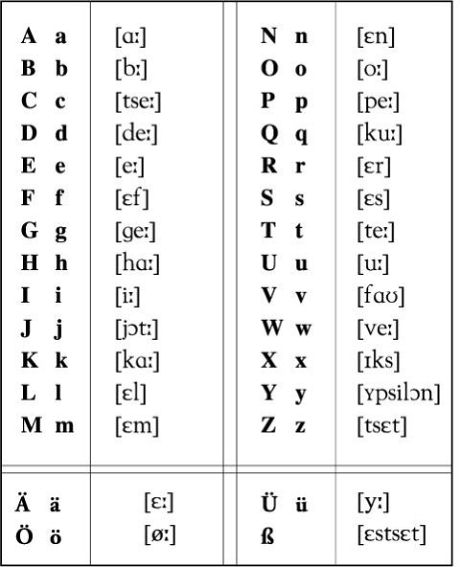
German alphabet with pronunciation
Why is it worth learning German?
Connection with tourism
As you know, in countries such as Germany, Austria, Switzerland and Luxembourg, people speak predominantly German. However, knowing the German alphabet with pronunciation in Russian, you can also easily communicate with people from Liechtenstein, Poland, Denmark, the Czech Republic, northern Italy, eastern Belgium and some other countries.

German language is important for tourism
New useful acquaintances
You should be more confident in a foreign country. Knowing the language will greatly simplify communication with local residents. Knowing the German alphabet for beginners with pronunciation, you can easily meet new people, learn their character and interests.
Education and self-development
Many people strive to become more educated, to expand the range of their knowledge and skills, but in this matter what can be better study one or more foreign languages? It is worth noting that not only the quantity is taken into account, but also the level of mastery of them. The alphabet in German with pronunciation will help solve this problem.
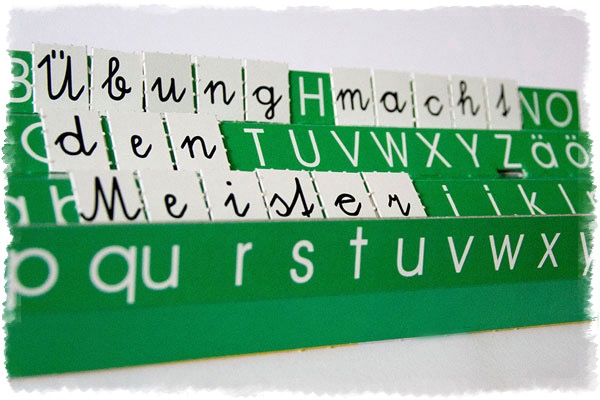
Work abroad
It's no secret that even the minimum wage in Europe can exceed Russian standards. With knowledge of at least one foreign language You can choose more than one prestigious profession, and also try to start your own business. Russian-speaking citizens will benefit from the German alphabet with Russian pronunciation.
Educational literature
Approximately 18% of the world's books are published in German. Of these, only a tiny part has been translated into Russian. Reading works in their original form allows a person to enrich himself with invaluable knowledge, learn more about the culture of a given country, and better understand the specifics of its language. The German alphabet with pronunciation will help you appreciate the fullness of works of art.
Consonants. Pronunciation
For beginners with pronunciation, it is advisable to remember such an important nuance that all German consonants are hard. The voiced ones are slightly muffled in pronunciation. The final consonant of the word is completely deafened.
Phonetics of the German language for beginners offers for analysis illustrative examples. The word dieb is thief. As can be seen from the transcription, the letter “d” is semi-voiced, and “b”, since it is at the very end, is significantly muted.
2. The letter “j” is similar to the Russian “y”. It is worth remembering the phrases “ja” and “ju”, which sound like “ya” and “yu”. For example, jahr, which translates as year or juni - June.
3. The letter “l” is always a little softened: blume – flower.
4. The letter “s” preceding the vowel is converted into the sound “z”: sonne - sun, verb lesen - read.
5. The letter "ß" is pronounced like "s". For example, groß – big.
6. The consonants k, p, t should be pronounced with a slight aspiration: park - park, torte - cake, ko†fer - suitcase.
7. It is important to note that the letter “v” is read not as “v”, but as “f”: vater - father. However, in borrowed words it can be pronounced as “in”: vase - vase.
8. The letter “w” should be pronounced by analogy with the Russian “v”: wort – word.
9. You should remember a small rule: double consonants sound like single consonants, shortening the vowel in front of them: rennen - rush, sommer - summer, mutter - mother.
Letter "r". Pronunciation Features
The German alphabet with pronunciation will help you master the alternative pronunciation of "r".
- If she starts a word, the sound will be a little burry and stretched out, like the Russian sound [x], but in in this case voice will play a direct role.
- Another pronunciation option is possible if the letter is at the beginning of the word. The sound will become more rolling and front-lingual [r].
- Toward the middle of the word, the [r] becomes much quieter, but still audible.
- It is worth noting that at the tail of the word the letter loses its original sound and is transformed into a vocalized [α], which is closer to a vowel.
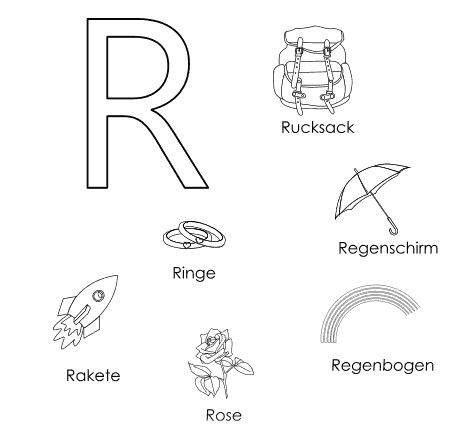
The German alphabet with Russian pronunciation provides an opportunity to practice comparative analysis. For example, in the word der rabe, which means raven, the sound [r] is predominantly loud and rolling. In the verb to teach – lehren, this sound will be more muffled, but will not lose its color. As for the word spectator - der zuschauer, in its example you can see how [r] turns into a vocalized [α].
Pronunciation of vowels
To convey the Russian letters ya, ё and yu, the German language uses special letter combinations ja, jo, ju.
They are able to most accurately convey the sound of analogue letters. For example, we can consider a couple of Russian names: Yura - Jura and Yasha - Jascha.
As for double vowels, they are read with one long sound. For example, eel – der Aal [a:l]. In the transcription you can see that the sound [a] is prolonged. The remaining vowels are read using the same principle: tee – tea; raar – pair; boot - boat.
If the vowel is located at the beginning or at the root of the word, the sound will be much sharper and harder, giving German speech a rougher character and abrupt phrases in comparison with the usual Russian speech. You can trace this intonation in the word der Alter [altә].
Letter combinations in vowels and consonants
The alphabet in German with pronunciation has its disadvantages. Not every sound is optimally described by a letter. Sometimes, to achieve the desired result, you have to resort to combining certain characters of the alphabet:
1. The combination of letters “ie” is converted into the drawn-out sound “i”. For example: bier - beer. And if you swap these symbols - “ei”, you get a short sound “ai”: heimat - homeland.
2. In combination with “u”, the letter “e” makes the sound “oh”: heute - today. The same sound can be obtained by combining the letter “ä” with “u”: bäume – trees. The features of this symbol will be discussed further.
3. The letter combination “sp” at the root or beginning of a word should be pronounced as “shp”: sport, which in translation means sport.
4. There is another sound similar to this - “piece”. It is formed by combining the letters "s" and "t" by analogy at the beginning or root. Example word: stern – star.
5. The pure sound “sh” is formed using three letters at once: s, c, h, coming in a row one after another. As an example: schule - school, schwester - sister.
6. The letter combination “ck” is pronounced like a short “k”: backen – oven. This sound also has variations: “ks” and “kv”. The first of them is formed by three letters: c, h, s. For example: sechs – six. And the sound “kv” can be obtained by combining two elements “q” with “u”: quark - cottage cheese.
7. It is impossible not to note such sounds as “x” and “ch”. They are an integral basis of the German language. As a rule, by combining “c” and “h” you can get a dull “x”: buch - book, machen - to do. And to get a short “h” you will need 4 letters at once: t, s, c, h. This combination is used in one very useful word: deutsch - German.
Unusual characters and their pronunciation
The German alphabet with pronunciation in Russian, the table of which is shown below, has specific letters that have a cap in the form of two dots. These characters also have their own pronunciation. For example, the sound of the letter “ä” is more similar to the Russian sound “e”: mädchen - girl.
The next letter is ö. It is very reminiscent of “ё” from the Russian alphabet and is read exactly like it. Example word: schön – beautiful.
And the last character is “ü”, by analogy with “yu”: müll - garbage.
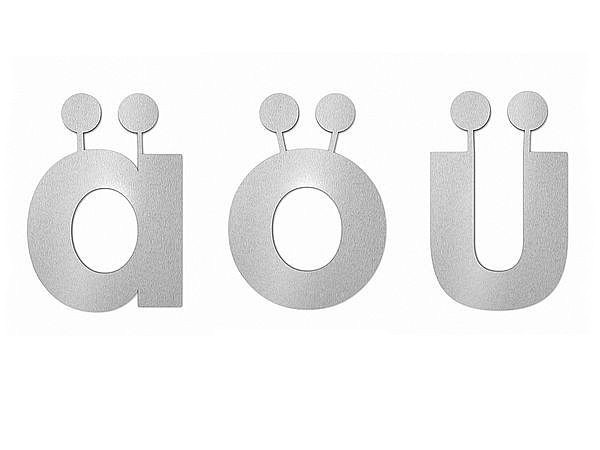
Features of stress
In German, stress usually falls on the first syllable. In words with an unstressed prefix, the stress moves to the next syllable. As an example, consider the suffix –tion. It will always be stressed and pronounced like, where “i” is a short slipping sound, and the emphasis falls on “o”.
As for the letter combinations “ts”, they form the sound “ts”. For example, you can take foreign word kommunikation, meaning connection or communication.
Words where the stress falls on the first syllable: ausländer - foreigner or aufmachen - to open. An exception to the rule is the common borrowing from foreigners of the word computer and others.
It is worth noting words with an unstressed prefix, these include: be-, ge-, er-, ver-, zer-, ent-, miss-. The stress in words with such prefixes will be shifted to the next syllable. For example: verkaufen – sell, bekommen – receive.
Simple words to practice pronunciation
German alphabet with pronunciation in Russian, table for practice simple words which is presented below, allows you to practice reading them, at the same time expanding your vocabulary.
- strand – beach;
- reise – journey;
- leute – people;
- zeit – time;
- frühling – spring;
- herbst – autumn;
- fleisch – meat;
- fisch – fish;
- wein – wine;
- kaffee – coffee;
- zwieback – cracker;
- radieschen - radish;
- richtig – correct;
- schule – school;
- volk - people.
DEUTSCH ALPHABET
German alphabet
In this article I will collect materials related to the German alphabet. Here you can download posters, cards, practice pronunciation and learn a lot of interesting things about the German alphabet.
A short introduction to DEUTSCH ALPHABET
As with English and French, the German alphabet is based on Latin letters: A a, B b, C c, D d, E e, F f, G g, H h, I i, J j, K k, L l, M m, N n, O o, P p, Q q , R r, S s, T t, U u, V v, W w, X x, Y y, Z z, besides them there are also umlauts: Ä ä, Ö ö, Ü ü and ligature ß.
In total we get 26+3+1= 30 characters. I would like to note that umlauts and ligatures are not considered letters, so the correct answer to the question “how many letters are in the German alphabet?” will be - 26.
Letters of the German alphabet
Pronunciation chart of the German alphabet.
The table shows the Russian and classical versions of transcriptions. The Russian version is not entirely correct and rather serves as a hint.
You can also download a file with such a table for printing on a printer.
MS Word file prepared for printing to a printer. The archive contains two files: front and reverse side cards.
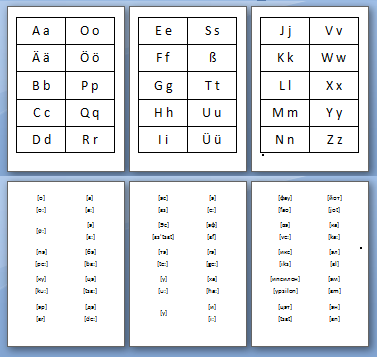
Download the file with cards in MSWord format.
File name: Deutsches_Alphabet_flashcards_ru_en.rar
Archive composition: Deutsches_Alphabet_1.rtf, Deutsches_Alphabet_2.rtf
File type: RAR
If you don't like paper cards, try the electronic version. Funny pictures, transcription and voice-over by a narrator should make the process of memorization german letters interesting and effective for children and adults.
Example:
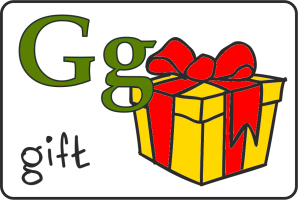
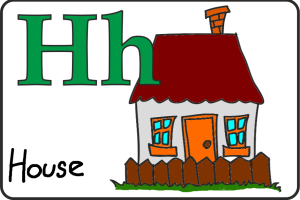
go to full version lesson:
Large poster with letters of the German alphabet. Vowels and consonants are highlighted separately, there are umlauts and eszet. No transcriptions.
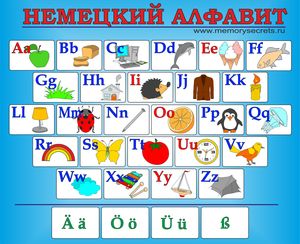
File: Alphabet Poster_1.jpg
Size: 900 KB
A similar poster, only with a classic transcription.
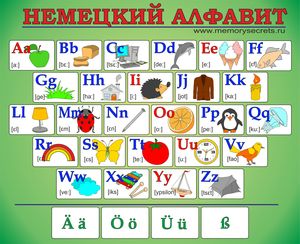
File: Alphabet Poster_2.jpg
Size: 900 KB
Everything is the same, only with Russian transcription.
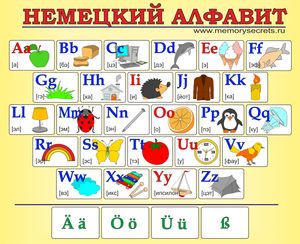
File: Alphabet Poster_3.jpg
Size: 900 KB
Umlauts Ä, Ö, Ü.
Umlauts or umlauts?
The question often arises of how to write correctly "umlauts" or "umlauts"? In fact, both ways are true, everything will depend on how you read the word "Umlaut". The word is used more often "umlaut", let’s take it as truth.
So, what is an umlaut if not a letter?
Omitting scientific terms and definitions, umlaut can be called a sound phenomenon that consists in changing the sound and timbre of vowels.
There are three umlauts in German Ä ä, Ö ö, Ü ü.
As you can see, they are distinguished from ordinary vowels by the presence of two dots above the letter.
In order to correctly pronounce sounds when reading umlauts, remember the following rules:
- Ä. If you see this symbol after a vowel or at the beginning of a word, it will read “E”, and if it comes after a consonant, then “E”.
- O. Tongue in position as when pronouncing “E”, lips as when pronouncing “O”
- Ü. Tongue in position as when pronouncing “I”, lips as when pronouncing “U”
Some examples:
- Die Hande
- Die Ähre
- Österreich
- Zwölf
- Wunderschön!
- Die Übung
- Zu küssen
- Kuhl
- Die Manner
- Hauser
- Die Hofe
- Die Bucher
- Die Gäste
As individual characters, the umlauts are read like this:
- "ä" - a-umlaut
- "ü" - u-umlaut
- "ö" - o-umlaut
More about umlauts:
In some cases, for example if there is no German keyboard layout, umlauts can be replaced with digraphs (two letters):
- ä - ae
- ü - ua
- ö-oe
In the German alphabet, umlauts come immediately after the corresponding vowels, which is useful when searching for dictionary entries.
How to insert an umlaut character if there is no German keyboard layout? Besides buying a keyboard, there is another way:
- Ä - Hold down the “Alt” key and press “0228” one by one
- Ü - Hold down the “Alt” key and press “0252” one by one
- Ö - Hold down the “Alt” key and press “0246” one by one
At the same time, do not forget to switch the keyboard layout to English.
Ligature ß (es-cet)
Another sign that requires special attention in the German alphabet is eszet. This is not exactly a letter, an esset is a ligature, or, more simply put, a sign that combines two letters “ f" And " S»:
f+s= ß
In words, esset is read as a long “ WITH" For example: weiß - weiss, groß - gross, Straße [strasse]
Some examples:
- der Floß
- der Fuß
- die Größe
- der Gruß
- das Maß
- die Muße
- die Straße
- die Soße
- der Stoß
More about the ß sign:
- "scharfes s" is the second name of ß
- If you do not have a German keyboard layout, ß can be safely replaced with ss.
- For the case when you doubt whether to write “ss” or “ß”, there is a rule: the esset is written only after long vowels, in other cases the double S is written.
When sorting dictionary entries, "ß" is equivalent to double "S".
The ß figure is used only in Germany and Austria; in other countries it is replaced by “ss”.
On June 25, 2008, the capital letter “ß” was included in the technical standards. Before this, for 130 years there had been debate about whether the Germans needed a large esset. Let me remind you that ß can be either in the middle or at the end of a word.
I would be grateful if you tell your friends about this article:



